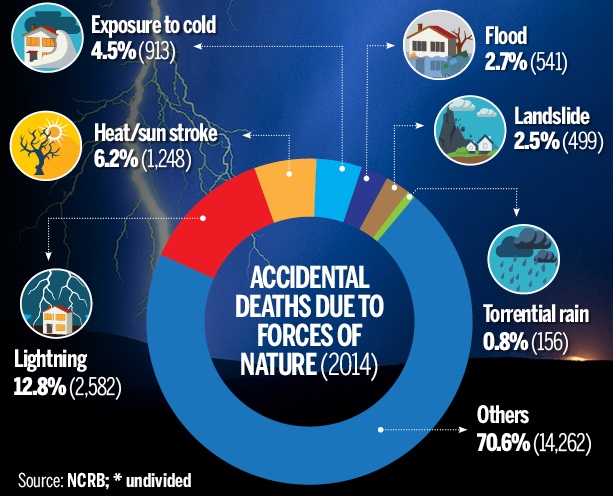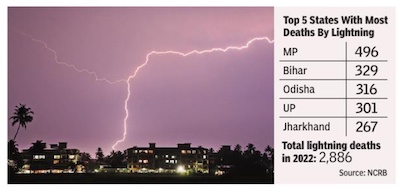Lightning strikes: India
This is a collection of articles archived for the excellence of their content. |
Contents |
Lightning strikes: India
2014: Deaths caused by lightning




The Times of India, Sep 08 2015
In 2014, more than 20,000 people were killed by accidents caused by forces of nature.Among the known reasons of these deaths, the largest chunk were due to lightning, which alone killed more than 2,500 people. It was followed by heat sun stroke, exposure to cold and flood, each causing more than 500 deaths. A state-wise comparison of lightning deaths shows that the highest number of causalities was reported in Madhya Pradesh, where over 400 people lost their lives.Andhra Pradesh, where 19 people got killed by multiple lightning strikes on Sunday, witnessed 69 deaths in 2014.
2019
In MP
Ankur Sirothia , Oct 26, 2019: The Times of India
Madhya Pradesh had the highest number of lightning deaths in the country in August-September this year. At least 150 people were killed in these two months, and there were over 6.25 lakh lightning flashes across the state — twice as many as second-place UP.
This is in addition to 102 lightning deaths between April 1 and July 1, which means 250 people were struck dead by lightning in six months. Between April and July, MP was fifth in lightning strikes at 4.81 lakh. But in the next two months, it blazed to first place with 6.24 lakh lightning strikes. UP came second with 2.96 lakh strikes.
2010-2020: alarming spike in deaths
August 27, 2024: The Times of India
Hyderabad : There has been an alarming spike in deaths due to lightning strikes across country between 2010 and 2020. And climate-change induced extreme weather may only trigger more deaths, reports Pinto Deepak.
Researchers led by Fakir Mohan University, Balasore, Odisha, studied National Crime Records Bureau data to find that lightning caused 1,01,309 deaths between 1967 and 2020, with a sharp rise in casualties between 2010-2020. Data shows there has been a rise in average annual fatalities per state and UT from 38 during 1967-2002 to 61 between 2003-2020. The study was published in the journal, Environment, Development and Sustainability.
“Data shows that an average of 1,876 deaths are reported (in country) annually,” said Prof Manoranjan Mishra of the university’s geography department, who authored the study, Lightning-related Fatalities in India (1967–2020): Detailed Overview of Patterns and Trends. “Increased frequency and intensity of lightning strikes due to evolving climatic conditions has led to a sharp rise in fatalities in India over the years,” he told TOI.
According to the data, almost a third of the deaths (29,804) took place between 2010 and 2020 while the first four decades registered 71,505 deaths. Central and northeast India account for the highest incidence of lightning deaths. Data also revealed that central India alone accounts for 50,884 (50%) deaths.
Prof Mishra attributed the increased incidence of lightning strikes to environmental degradation, climate change, regional variability, high population exposure, geographical and climatic diversity, inadequate early warning systems and socio-economic factors.
2020: 1,771 lightning deaths
Shobita Dhar, January 9, 2021: The Times of India

From: Shobita Dhar, January 9, 2021: The Times of India
India’s first ever Annual Lightning Report (2019-2020), released on December 31, has recorded 1,771 deaths due to lightning between April 1, 2019, and March 31, 2020. This despite the fact that the country has 82 lightning detectors, apps that deliver alert notifications for upcoming incidents, and the IMD can relay immediate lightning forecasts for the next three hours.
According to experts, the problem is the last mile delivery of the warning. The report hopes to address this gap by providing extensive state-wise data on lightning strikes, fatalities and patterns. The maximum number of lightning deaths, 293, was reported in Uttar Pradesh, followed by 248 in Madhya Pradesh, 221 in Bihar, 200 in Odisha, and 172 in Jharkhand. However, the number of deaths reduced by about 25% from 2018.
‘Standing under trees linked to 71% of lightning deaths in India’
The report, compiled based on numbers as received from state governments, media and volunteers, and as part of ‘The Lightning Resilient India Campaign’ launched in April 2019, is a joint initiative by Climate Resilient Observing Systems Promotion Council, IMD, ministry of earth science, GoI, Indian Institute of Tropical Meteorology, India Meteorological Society and World Vision India.
In India, every third death due to natural hazards is due to lightning. Nearly 42,500 people were killed by lightning strikes between 2001 and 2018, as per NCRB data. “The northeastern states and the Chota Nagpur Plateau region were identified as lightning hotspots. Tribals in Odisha and Jharkhand were found to be especially vulnerable because their livelihood depends on working outdoors,” said colonel Sanjay Kumar Srivastava, chairman, Lightning Resilient India Campaign and CROPC.
As per the report, the maximum number of fatalities — over 200 — were reported between July 25 and 31, 2019. During Cyclone Fani, Odisha received over one lakh lightning strikes but there were no fatalities because all the 891 cyclone shelters were fitted with lightning arresters. Standing under a tree is the top primary cause of lightning deaths in India, 71% are because of it.
B
Vishwa Mohan, July 20, 2021: The Times of India

From: Vishwa Mohan, July 20, 2021: The Times of India
India had last year recorded a nearly 23% increase in lightning episodes compared to 2019 with Tamil Nadu, Andhra Pradesh, Karnataka, Odisha and West Bengal turning out to be among the top vulnerable states in terms of reporting this weather phenomena.
Though the lightning along with thunderstorm had claimed more lives in Bihar, UP, Jharkhand and Maharashtra compared to the top five that reported lightning episodes last year, the increase in number of such events, recorded by the Earth Networks — a private agency of a nationwide lightning detection network in India — shows vulnerability of most parts of the country.
The Earth Networks report, released on Monday, shows its network had detected nearly 39.6 million lightning pulses in India in 2020, of which just over 13 million were dangerous ‘cloud-to-ground’ strikes — the lightning which hit the ground, putting lives and property in danger.
“It’s a huge number which practically makes a large part of the country vulnerable,” Kumar Margasahayam of the Earth Networks, told TOI.
He said issuing timely alerts as part of a robust early warning system, dissemination of the alerts for vulnerable populations and creating awareness among people about the danger of lightning were the three crucial steps to save lives. “India is extremely susceptible to severe weather events,” he said.
2023
61,000 lightning strikes in two hours in Odisha
Minati Singha, Sep 4, 2023: The Times of India
Twelve people died and 14 others were injured in 61,000 lightning strikes across Odisha in two hours on Saturday. The IMD has issued a warning of extreme weather conditions in the state till September 7 with an active cyclonic circulation likely to cause widespread rain, reports Minati Singha.
Four of the deceased in the lightning strikes were from Khurda district, two from Balangir and one each from Angul, Boudh, Dhenkanal, Gajapati, Jagatsinghpur and Puri. An ex gratia of Rs 4 lakh will be paid to each of the bereaved families.
The problem
The worst affected states and districts/ 2022
August 4, 2024: The Times of India

From: August 4, 2024: The Times of India
Hotter summers combined with heavy rain lead to rise in strikes while lack of awareness makes the poor more vulnerable
TIMES NEWS NETWORK
In June last year, as strong winds started blowing in Jamtoli village, which is in Gumla district about three hours from Ranchi, 10-yearold Deepak Sahu’s eyes lit up. “Mangoes!” he thought, as he clambered on his bicycle. He was joined by an equally enthusiastic 14-year-old Savita and some other friends in anticipation of a feast.
But as the group pedalled down the dirt track towards the mango orchards, not only did the rain become heavier but a storm accompanied with lightning began. “Deepak and Savita were scared and took shelter under a tree while the rest ran back to the village for safety,” Rajesh Sahu, Deepak’s uncle recalls. The decision proved to be catastrophic.
When the storm ended, villagers set out in search. Deepak and Savita, who had been struck by lightning, were rushed to the nearby hospital, but it was too late. Even a year later, Jamtoli continues to reel under the loss. Even worse, residents continue to be unaware that taking shelter under trees during lightning can be fatal.
Officials say that Gumla district alone recorded 30 deaths by lightning in 2023. This is not an isolated example of one district in Jharkhand. Thousands of people, especially in central and east India, die in lightning strikes every year. According to NCRB data, out of 8,060 accidental deaths in India attributable to forces of nature like flood, earthquake, tsunami, about 36% or 2,886 deaths were due to lightning in 2022, up from 1,165 deaths in 1967.
In novels and Hindi movies, lightning or ‘bijlee’ is romanticised and used to describe love at first sight. But in real life, strikes are becoming deadlier. Col Sanjay Srivastava (retd), principal scientist-cum-convener of the Lightning Resilient India Campaign, says climate change is behind the rise in lightning strikes as heat and moisture are two basic ingredients for thunderstorms. “This is aggravated by deforestation, depletion in water bodies, urbanisation, rise in aerosol levels due to pollution, rampant mining, industrialisation, among other factors,” he adds.
Incidentally, analysis of lightning deaths over two decades shows that they are more likely to occur in the afternoon. Almost 88% of fatalities are reported from seven states including MP, UP, Bihar and Odisha. The reason is frequency of strikes and density of population. Also, lightning victims belong to the rural population (96%), mostly farmers, cattle grazers, and jungle hunters. Like Arti and her 15-year-old daughter Ananya from UP’s Bharatpur village, who were preparing the land for sowing in July amid the busy paddy season when it started raining heavily. Arti’s husband Mahendra Mishra, who was working on another field, rushed home and waited for them. “When they did not return for some time, my nephew and I went out to search. We found their bodies near the field. They had been struck by lightning,” he says in tears. Besides population density, research by Indian Institute of Tropical Meteorology suggests that topography makes certain areas more vulnerable to lightning strikes. Jharkhand, for instance, is close to Bay of Bengal and located in the Chhota Nagpur Plateau with an undulating landscape and tropical forests, while in Odisha open casting mining and industrialisation could impact the increase in strikes. This plays a vital role in creating weather variability, Srivastava, who is also chairman of the Climate Resilient Observing-Systems Promotion Council (CROPC) says.
CLIMATE CHANGE IMPACT
In MP, where at least 80 people have been killed by lightning in July this year, it is a combination of an extremely hot summer followed by a heavy monsoon that often leads to a surge in lightning strikes. “If land gets hotter due to an excessively hot summer, and monsoon rain comes in contact with the baking earth, heat is transferred and lighting strikes begin within half an hour to three hours,” says a weather expert. The maximum deaths, 35, occurred in Jabalpur division, which has been tagged a ‘severe lightning vulnerable zone’, followed by Shahdol and Sagar divisions. Senior Met scientist (Bhopal circle) Ved Prakash Singh says that when south-easterly winds hit the Satpura Range, strong clouds develop due to local orographic (hill, mountain) factors, triggering a blaze of lightning strikes.
Former IMD director general K J Ramesh says global warming has an indirect bearing on lightning strikes as it impacts rain-bearing systems. “There is more lightning in August and September as these are months of heavy rain,” he explains.